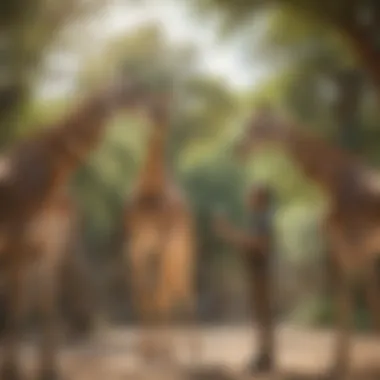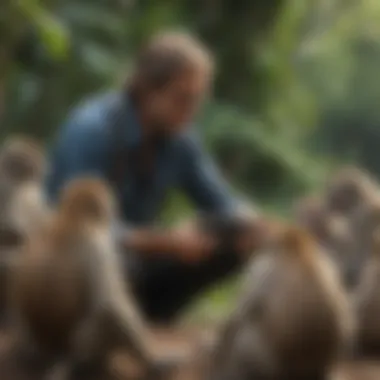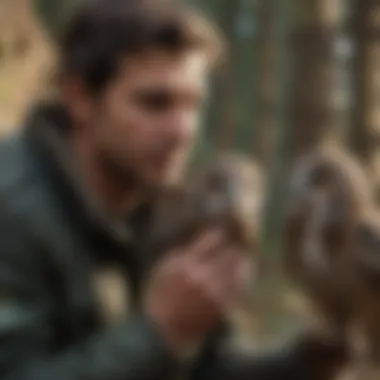Exploring Diverse Career Paths in Animal Interaction


Animal Species Profile
India, with its rich biodiversity, offers a myriad of animals to explore careers in. From the majestic Bengal tiger to the playful Indian elephant, opportunities abound for those passionate about animal welfare. Each species boasts unique physical characteristics and behaviors, making the field of working with animals a fascinating and rewarding endeavor.
Bengal Tiger
Introduction to the Bengal Tiger
The Bengal tiger, scientifically known as Panthera tigris tigris, is the national animal of India, symbolizing strength and grace. Known for its striking orange coat with dark stripes, this apex predator exudes power and agility.
Physical Characteristics and Appearance
Renowned for its muscular build and predatory prowess, the Bengal tiger stands out as one of the largest big cats in the world. With males weighing up to 500 pounds and females around 300 pounds, these carnivores dominate their territories with awe-inspiring majesty.
Natural Habitat and Distribution
Found predominantly in the Indian subcontinent, Bengal tigers inhabit diverse regions such as dense forests, mangroves, and grasslands. Their range spans across national parks and reserves like the Sundarbans in West Bengal and Jim Corbett National Park in Uttarakhand.
Behavior and Social Interactions
Despite their solitary nature, Bengal tigers showcase social behaviors during mating and raising offspring. Through vocalizations, scent marking, and body language, these big cats communicate within their territories, establishing dominance and breeding rights.
Indian Elephant
Introduction to the Indian Elephant
Admired for their gentle demeanor and intelligence, Indian elephants symbolize wisdom and strength in Indian culture. These herbivorous giants play a crucial role in the country's ecological balance and cultural heritage.
Physical Characteristics and Appearance
With their massive bodies, long trunks, and distinctive tusks, Indian elephants command attention wherever they roam. Their gray skin, floppy ears, and swaying trunks evoke a sense of serenity and grandeur.
Natural Habitat and Distribution
Indian elephants thrive in diverse habitats ranging from lush forests to grassy plains. From the Western Ghats to the Himalayan foothills, these gentle giants navigate their environments with unparalleled grace and resilience.
Behavior and Social Interactions
Known for their strong social bonds, Indian elephants live in matriarchal herds led by experienced females. Through intricate communication, tactile gestures, and vocalizations, these intelligent animals exhibit complex social dynamics and emotional sensitivity.
Introduction


Understanding the Animal Industry
The understanding of the animal industry is a crucial facet of this article. It serves as the foundation for individuals looking to venture into careers involving animals. By comprehending the intricacies of this industry, one gains insights into the diverse opportunities available and the potential impact they can have on animal welfare. Exploring the various sectors within the animal industry provides a comprehensive view of how different roles intertwine and contribute to the overall well-being of animals. Understanding the animal industry also emphasizes the significance of ethical practices, conservation efforts, and advancements in veterinary care, shaping the future of animal-related professions.
Exploring Job Roles
Dive into the world of animal-related professions
Diving into the world of animal-related professions opens up a realm of possibilities for individuals passionate about working with animals. This aspect delves deep into the day-to-day responsibilities of roles such as veterinarians, animal behaviorists, and zookeepers. By immersing oneself in these professions, individuals can make a tangible difference in the lives of animals through direct care, behavior analysis, and conservation initiatives. The key characteristic of delving into animal-related professions lies in the hands-on approach and the emotional fulfillment derived from nurturing and safeguarding animal well-being. This immersive experience not only nurtures a profound connection with animals but also cultivates empathy and advocacy for animal rights.
Discover the diversity of roles available
Discovering the diversity of roles available in the realm of animal care showcases the vast array of career paths within this industry. From working in research and rehabilitation to conservation and education, the possibilities are endless. Each role presents a unique set of challenges and rewards, catering to individuals with varied interests and expertise. The key characteristic of this exploration is the opportunity to specialize in a niche area that aligns with one's passion for specific animal species or aspects of animal care. By uncovering the diversity of roles, individuals can tailor their career paths to contribute meaningfully to animal welfare while pursuing personal and professional growth.
Educational Pathways
Explore academic requirements for various animal-centric careers
Exploring the academic requirements for animal-centric careers sheds light on the specialized knowledge and skills needed to excel in this field. From obtaining degrees in veterinary science to pursuing certifications in animal behavior, the educational pathway varies depending on the desired profession. The key characteristic of this exploration is the emphasis on continuous learning and skill development to stay abreast of advancements in animal care. By understanding the academic prerequisites, individuals can make informed decisions about their career trajectories and invest in education that aligns with their professional goals.
Understand the importance of specialized training
Understanding the importance of specialized training underscores the value of hands-on experience and specialized courses in honing skills related to animal care. Specialized training offers practical insights into handling diverse animal species, addressing health concerns, and implementing behavior modification techniques. The key characteristic of specialized training is its focus on providing practical solutions to real-world challenges faced in animal care settings. By emphasizing the importance of hands-on training, individuals can enhance their competencies and prepare for the dynamic nature of roles in animal-centric careers.
Career Options in Animal Care
When considering a career in animal care, it is essential to acknowledge the significant impact individuals can have on the well-being of animals. From veterinary medicine to zookeeping and animal behaviorist roles, there is a diverse array of career paths available in this field. Animal enthusiasts who pursue these opportunities not only contribute to the health and welfare of animals but also play a crucial role in conservation efforts and promoting understanding of animal behavior. Exploring career options in animal care opens up a world of possibilities for those passionate about working with animals.
Veterinary Medicine
Role of a veterinarian in animal healthcare
Veterinary medicine plays a pivotal role in maintaining the health and well-being of animals. Veterinarians are tasked with diagnosing illnesses, performing surgeries, prescribing medications, and offering preventive care to a wide range of animal species. The unique feature of a veterinarian's role lies in their ability to provide medical attention to pets, livestock, wildlife, and exotic animals, showcasing the diverse nature of this profession. Despite its challenges, such as long working hours and emotional stress, veterinary medicine remains a rewarding choice for individuals dedicated to animal welfare.
Challenges and rewards of veterinary work
The field of veterinary medicine presents both challenges and rewards for professionals. Dealing with sick or injured animals, making tough medical decisions, and communicating with distraught pet owners can be emotionally taxing. However, the satisfaction of nursing an animal back to health, the bond formed with animal patients, and the gratitude of owners bring immense fulfillment to veterinary work. The challenges encountered in this field are often surpassed by the rewarding moments of making a difference in an animal's life, making veterinary medicine a compelling career choice.
Zookeeper
Responsibilities of a zookeeper
Zookeepers play a crucial role in the daily care and management of animals in captivity. Their responsibilities include feeding, providing enrichment activities, monitoring animal behavior, and ensuring the well-being of zoo inhabitants. The key characteristic of a zookeeper's role is the hands-on interaction with a variety of species, from large mammals to exotic birds, making it an exciting and enriching career choice. While the physically demanding nature of the job and exposure to potential risks are considerations, the opportunity to educate visitors about wildlife conservation and animal welfare adds significant value to a zookeeper's role.


Importance of conservation in zoo settings
Conservation efforts within zoo settings are vital for preserving endangered species and raising awareness about wildlife conservation. Zoos serve as educational platforms where visitors can learn about animal habitats, threats to biodiversity, and the importance of species conservation. The unique feature of integrating conservation initiatives into zoo operations highlights the role zoos play in promoting environmental stewardship and sustainable practices. While challenges such as limited funding and space constraints exist, the opportunity to contribute to species survival through public engagement makes conservation in zoo settings a critical aspect of modern zoological facilities.
Animal Behaviorist
Study of animal behavior and its significance
Animal behaviorists study the behavior patterns, instincts, and social interactions of animals to understand their psychological needs and promote their well-being. By observing and analyzing animal behavior, behaviorists can address issues such as aggression, anxiety, and phobias in domesticated pets or captive wildlife. The key characteristic of this role lies in its focus on enhancing the relationship between humans and animals through behavior modification and training techniques. Despite the challenge of interpreting non-verbal communication and the time-intensive nature of behavior analysis, the ability to improve animal welfare and strengthen human-animal bonds makes the study of animal behavior a valuable profession.
Training and certification for behaviorists
Becoming a certified animal behaviorist requires specialized training in psychology, animal behavior, biology, and ethology. Professionals in this field often pursue advanced degrees or certifications to enhance their knowledge and practical skills. The unique feature of training as an animal behaviorist is the emphasis on evidence-based practices, hands-on experience with diverse animal species, and continuous professional development. While the demanding academic requirements and competitive nature of the job market pose challenges, the opportunity to make a positive impact on the lives of animals and their caregivers motivates individuals to pursue a career in animal behavior.
Specialized Fields in Animal Welfare
Specialized Fields in Animal Welfare play a crucial role in the realm of animal care and conservation. These specialized fields encompass diverse avenues within animal welfare, focusing on areas such as research, rehabilitation, and advocacy. By delving into specialized fields, individuals can contribute significantly to the well-being and protection of various animal species. This section sheds light on the significance of specialized fields in animal welfare, providing insights into the pivotal role they play in ensuring the welfare and sustainability of animal populations.
Marine Biologist
Exploring marine ecosystems and conservation efforts
Exploring marine ecosystems and conservation efforts entail in-depth research and monitoring of marine habitats to preserve biodiversity and mitigate environmental threats. Marine biologists delve into the intricate ecosystems of oceans, studying marine species and their interactions to promote conservation initiatives. The emphasis on understanding marine ecosystems underscores the importance of maintaining ecological balance and protecting vulnerable marine life forms.
Job outlook and research opportunities in marine biology
Examining the job outlook and research opportunities in marine biology unveils a dynamic field ripe with prospects for growth and innovation. As concerns regarding marine conservation escalate, the demand for skilled marine biologists continues to rise. This section illuminates the diverse research avenues and career pathways available in marine biology, highlighting the rewarding yet challenging nature of this profession.
Wildlife Rehabilitator
Rehabilitation of injured or orphaned wildlife
Taking care of injured or orphaned wildlife involves providing critical care and rehabilitation to help these animals recover and thrive in their natural habitats. Wildlife rehabilitators exhibit compassion and expertise in nurturing wildlife back to health, emphasizing the importance of human intervention in supporting vulnerable animal populations.
Requirements and challenges of wildlife rehabilitation
Navigating the requirements and challenges of wildlife rehabilitation demands resilience and dedication from animal care professionals. From obtaining permits to acquiring specialized skills, wildlife rehabilitators face a spectrum of challenges in their efforts to safeguard wildlife welfare. This section delves into the intricate demands of wildlife rehabilitation, shedding light on the multifaceted nature of this rewarding yet demanding vocation.
Animal Sanctuary Manager
Role in providing lifelong care to rescued animals


The role of an animal sanctuary manager extends beyond day-to-day operations to ensure the well-being and longevity of rescued animals under their care. These managers oversee the sanctuary's activities, including animal health, enrichment programs, and staff management, emphasizing the commitment to providing a nurturing and secure environment for rescued animals.
Sustainability and fundraising in animal sanctuaries
Ensuring the sustainability of animal sanctuaries involves strategic planning and resource management to maintain operations and expand conservation efforts. From implementing eco-friendly practices to organizing fundraising campaigns, animal sanctuary managers strive to secure resources for the sanctuary's operations. This section explores the intricate balance between sustainability and fundraising in animal sanctuaries, highlighting the importance of community engagement and financial viability.
Emerging Trends in Animal-Related Careers
In the realm of animal-related careers, staying abreast of emerging trends is vital for professionals seeking to make a meaningful impact in this dynamic field. As the world evolves, so do the challenges and opportunities within the animal-care sector. By exploring the latest developments in animal-related careers, individuals can adapt their skill sets and approaches to meet the growing demands of a diverse and interconnected society. Understanding emerging trends allows for the integration of innovative practices, technologies, and methodologies that can revolutionize how we care for and interact with animals.
Animal-Assisted Therapy
Impact of animals on human mental health
One of the most intriguing aspects of animal-assisted therapy is its profound impact on human mental health. Interactions with animals have been shown to reduce stress, anxiety, and feelings of isolation, enhancing overall well-being. The non-judgmental nature of animals creates a safe space for individuals to express emotions and build trust. Incorporating animals into therapy sessions can trigger the release of oxytocin, a hormone associated with bonding and relaxation, thereby improving mood and reducing symptoms of mood disorders. The simple presence of a furry companion can significantly improve emotional resilience and social skills, making animal-assisted therapy a valuable option for individuals seeking holistic mental health support.
Training and certification for therapy animals
When delving into the realm of animal-assisted therapy, obtaining the necessary training and certification for therapy animals is a crucial step. Therapy animals undergo rigorous training to ensure they can safely and effectively interact with diverse populations in therapeutic settings. Certification processes evaluate the animal's temperament, obedience, and ability to remain calm and focused amidst various stimuli. Training programs instill important skills in handlers, teaching them how to facilitate meaningful interactions between animals and clients while maintaining a secure and respectful environment. By investing in proper training and certification for therapy animals, practitioners uphold the highest standards of care and professionalism in animal-assisted therapy practices.
Animal Nutritionist
Role in advising on proper nutrition for pets and livestock
The role of an animal nutritionist is indispensable in promoting the health and well-being of pets and livestock. Through comprehensive dietary analysis and personalized nutrition plans, animal nutritionists offer tailored guidance to ensure optimal nourishment for animals of all species. By studying the nutritional requirements of different animals and understanding the impact of diet on overall health, these experts play a pivotal role in preventing nutritional deficiencies, addressing health concerns, and enhancing performance. Collaborating with pet owners, farmers, and veterinary professionals, animal nutritionists provide crucial insights into selecting appropriate feeds, supplements, and dietary strategies to support the diverse needs of animals in various environments.
Educational background needed for a career in animal nutrition
Embarking on a career as an animal nutritionist requires a solid educational foundation in animal science, biology, or a related field. A deep understanding of biochemistry, physiology, and animal metabolism is essential for assessing dietary needs and formulating balanced nutrition plans. Graduates with degrees in animal nutrition or animal science gain expertise in nutrient requirements, feed analysis, and feed formulation, preparing them to address the complex nutritional challenges faced by domestic and agricultural animals. Continuous learning and professional development are key to staying abreast of advancements in animal nutrition research and applying evidence-based practices to optimize animal health and performance.
Conservation Biologist
Efforts to protect endangered species and their habitats
Conservation biologists are at the forefront of safeguarding biodiversity by implementing strategies to protect endangered species and their habitats. Through field research, habitat restoration, and conservation initiatives, these dedicated professionals work diligently to reverse the effects of habitat destruction, poaching, and climate change on vulnerable wildlife populations. By monitoring species populations, studying ecosystem dynamics, and advocating for conservation policies, conservation biologists strive to ensure the long-term survival of threatened species and ecosystems. Their efforts embody a commitment to preserving the rich tapestry of life on Earth for future generations to appreciate and cherish.
Collaboration with government agencies and conservation organizations
Collaboration with government agencies and conservation organizations is paramount for conservation biologists to achieve impactful outcomes in their field. By partnering with policymakers, environmental agencies, and non-profit organizations, conservation biologists can influence conservation policies, secure funding for critical projects, and mobilize collective action to address environmental challenges. Collaborative efforts facilitate knowledge sharing, data exchange, and coordinated conservation strategies, amplifying the effectiveness of conservation initiatives on local and global scales. By uniting diverse stakeholders under a common conservation agenda, conservation biologists can leverage collective expertise and resources to enact meaningful change in the preservation of biodiversity and the protection of natural habitats.
Conclusion
Reaching the concluding section of this extensive discourse on exploring career options in working with animals, we confront the paramount importance of reflecting on the knowledge imparted throughout. The essence of this conclusion lies in unveiling the myriad opportunities that exist within the realm of animal-related professions, aiming to offer a profound understanding for aspiring individuals who seek to immerse themselves in this field. By delving into the diverse tapestry of roles and responsibilities associated with animal care, we have illuminated the path for enthusiasts and professionals alike to navigate the nuances of working closely with diverse species and their unique needs.
In dissecting the intricate web of opportunities that the animal industry presents, we have uncovered a rich tapestry of career paths that beckon those with a passion for the welfare of creatures both great and small. From the poignant role of a wildlife rehabilitator in tending to injured or orphaned fauna to the strategic guidance provided by animal sanctuary managers in ensuring lifelong care for rescued beings, each profession encapsulates a realm of dedication and stewardship unseen in conventional careers. The Conclusion serves as a beacon, guiding readers towards a deeper comprehension of the holistic ecosystem of animal care and the indispensable roles played by those within it.
Moreover, this final segment provides not merely an endpoint but a gateway to reflection, urging individuals to ponder the significance of their potential contributions to the animal kingdom. By encapsulating the insights garnered from this exploration into working with animals, readers are prompted to consider the ethical implications, personal fulfillment, and societal impact of pursuing a career in this field. The Conclusion acts as a springboard for contemplation and action, prompting readers to embark on a journey of self-discovery and professional realization within the realms of animal welfare and care.
As the curtain falls on this elucidative narrative, readers are encouraged to perceive the global tapestry of animal-related careers not as disparate entities but as interconnected threads weaving a fabric of compassion, education, and advocacy for all beings. The hierarchy of significance within these roles is not defined by complexity or stature but by the dedication and devotion each individual brings to their craft. In essence, the Conclusion serves as a parting call to arms, summoning forth a new generation of advocates, caregivers, and stewards ready to embrace the challenges and rewards of working with animals.







